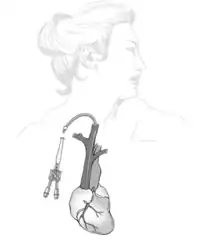Dialysis catheter
A dialysis catheter is a catheter used for exchanging blood to and from a hemodialysis machine and a patient.

The dialysis catheter contains two lumens: venous and arterial. Although both lumens are in the vein, the "arterial" lumen, like natural arteries, carries blood away from the heart, while the "venous" lumen returns blood towards the heart. The arterial lumen (typically red) withdraws blood from the patient and carries it to the dialysis machine, while the venous lumen (typically blue) returns blood to the patient (from the dialysis machine). Flow rates of dialysis catheters range between 200 and 500 ml/min.
If a patient requires long-term dialysis therapy, a chronic dialysis catheter will be inserted. Chronic catheters contain a dacron cuff that is tunneled beneath the skin approximately 3–8 cm. The tunnel is thought to add a barrier to infection. The most popular dialysis catheter sold on the market today is the Symmetrical-Tip dialysis catheter. This catheter is in the form spiral Z shape.

Catheter placement
The catheter is placed in one of the large veins. A common site is superior vena cava or SVC. An SVC catheter is placed by puncturing the internal jugular vein in the neck (most often on the right side), and the catheter is then advanced downwards toward the chest. Alternatively, an SVC catheter can be inserted via the subclavian veins. The femoral route is an inferior option, however, because the groin site is more prone to infection and also because the patient cannot sit upright.
Complications
Some common malfunctions of dialysis catheters include clotting, infection, and kinking. One of the most common errors of tunnel hemodialysis catheter insertions is failure to locate the arterial limb of the catheter medially and the venous limb laterally. This must be done, because most catheters have a memory in the plastic, which will cause the catheter to try to resume its natural straight form. If the arterial limb is placed laterally, this will cause the arterial inlet to float up against the vein wall, or even up against the rim of the inlet of the atrium. This has the same effect as a vacuum cleaner hose sucking up against curtains. This results in poor blood flows, and can force the dialysis staff to reverse flow, using the venous limb of the catheter as the arterial. This will result in more inefficient dialysis, as there will be admixing of blood from the catheter (cleaning the same blood, over again). A dialysis catheter must have infusion of 30cc or greater to keep the line open. Intravenous fluids at 30ml per hour should be hung if being used for infusion.
Fistulas versus catheters
Surgically created arteriovenous fistulae are preferred over catheters for patients with chronic kidney failure,[1] as the risk of infections (e.g., endocarditis, bacteremia), hospitalization and death are lower.[2][3]
References
- Huijbregts HJ, Blankestijn PJ. Dialysis access--guidelines for current practice. Eur J Vasc Endovasc Surg. 2006 Mar;31(3):284-7. PMID 16500586.
- McGill RL, Marcus RJ, Healy DA, Brouwer DJ, Smith BC, Sandroni SE. AV fistula rates: changing the culture of vascular access. J Vasc Access. 2005 Jan-Mar;6(1):13-7. PMID 16552677.
- Allon M, Daugirdas J, Depner TA, Greene T, Ornt D, Schwab SJ. Effect of change in vascular access on patient mortality in hemodialysis patients. Am J Kidney Dis. 2006 Mar;47(3):469-77. PMID 16490626.
External links
 Media related to Dialysis catheter at Wikimedia Commons
Media related to Dialysis catheter at Wikimedia Commons